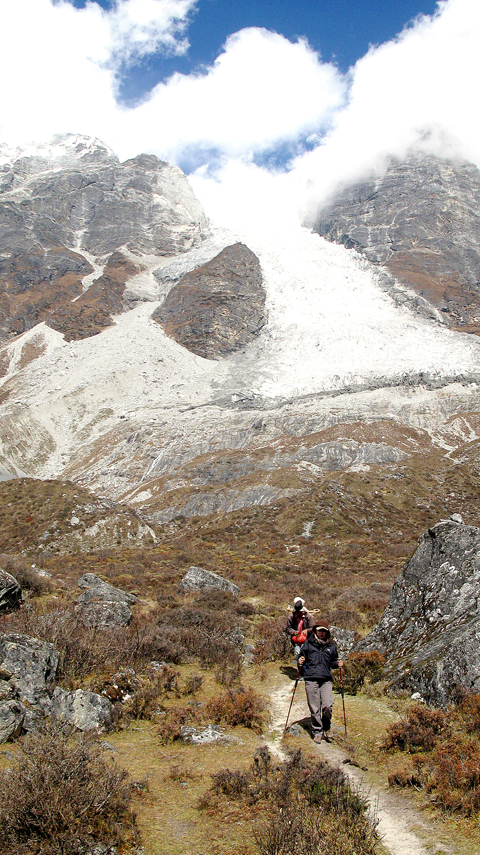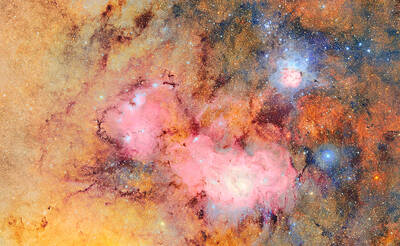Standing in the Himalayan valley of Langtang, Rinjin Dorje Lama remembers where he used to play as a child in the 1960s.
“When I was a kid, it was a lot longer,” said Lama, pointing at the Lirung glacier surrounded by snowy peaks on Nepal’s northern border with Tibet.
“We used to play on the glacier, and it came right down to the monastery, but now it’s about 2km further back,” he said.

PHOTO: AFP
Temperatures in the Himalayas are rising by around 0.06ºC annually, a long-term study by the Nepalese department of hydrology showed.
The rate is far above the global average given last year by the UN’s senior scientists, who said surface temperatures have risen by a total of 0.74ºC over the past 100 years.
“I don’t really understand why the glacier has gone so far back, but I am told it’s due to global warming,” said Lama, whose weather-beaten face makes him look older than his 57 years.
Lama has witnessed other changes in the roadless valley, 60km northwest of Kathmandu, where sure-footed ponies remain the quickest form of transport.
“I feel that the sun is getting stronger, and in the past there used to be a lot more snow in winter. We used to get up to 2m in the winter, and it would stay for weeks. Last winter we only had 2cm,” he said.
On top of unpredictable weather, other dangers are increasing in Nepal’s mountains because of climate change.
As the meltwater flows off the glacier, lakes begin to form and grow.
When the pressure becomes too great, the lake walls burst and release millions of cubic tonnes of water that can wash away people, villages and arable land.
Researchers at the Nepal-based International Center for Integrated Mountain Development (ICIMOD) have said five major glacial lake floods have hit Nepal since 1970, as well as at least two in Tibet and one in Bhutan.
Ang Tsering Sherpa, who grew up in Nepal’s Everest region, has observed the growth of one glacial lake with growing concern.
“A small pond first appeared close to the Imja glacier in about 1962,” said Sherpa, who owns a trekking and expedition company in Kathmandu.
Last year, a research team from Japan measured the Imja lake as being 1.7km long, 900m wide and 92m deep.
“If that lake bursts, it will be like a tsunami,” said Sherpa, who estimates that the Imja glacier has been retreating at a rate of 60m per year. “Imagine the damage that will be caused by a lake emptying within minutes into a well-inhabited valley. The loss of life will be huge.”
The World Wildlife Fund (WWF) calculates there are 2,000 glacial lakes forming in Nepal and around 20 are in danger of bursting.
Mountain dwellers are seeing first hand the effects of global warming, but the changing climate will eventually have dire consequences for a much wider section of Asia’s population.
Himalayan snow and ice is a massive freshwater reserve that feeds nine of Asia’s major waterways, including the Indus, Ganges and Yellow rivers.
“In the long term, water scarcity will become a big problem,” said Sandeep Chamling Rai, WWF climate change officer. “There will eventually be a tipping point where the amount of water from the glaciers is hugely reduced, which will result in loss of water resources for people downstream who rely on these Himalayan-fed rivers.”
The ICIMOD said in August that climate change posed a serious threat to essential water resources in the Himalayans, putting the livelihoods of 1.3 billion people at risk.
Studies say much of the blame is due to the “Asia brown cloud” spewed from tailpipes, factory chimneys and power plants — as well as forests and fields that are burned for agriculture, and wood and dung burned for fuel.
Back in the Langtang Valley, where around 700 people and 4,000 yaks live, Lama can only watch as the ice and snow retreat from around his home.
“I am very worried, but what can we do? We are not contributing to global warming but we feel its effects. I am scared there will be no snow and ice in these mountains within the next 15 years,” he said.

The team behind the long-awaited Vera Rubin Observatory in Chile yesterday published their first images, revealing breathtaking views of star-forming regions as well as distant galaxies. More than two decades in the making, the giant US-funded telescope sits perched at the summit of Cerro Pachon in central Chile, where dark skies and dry air provide ideal conditions for observing the cosmos. One of the debut images is a composite of 678 exposures taken over just seven hours, capturing the Trifid Nebula and the Lagoon Nebula — both several thousand light-years from Earth — glowing in vivid pinks against orange-red backdrops. The new image

Canada and the EU on Monday signed a defense and security pact as the transatlantic partners seek to better confront Russia, with worries over Washington’s reliability under US President Donald Trump. The deal was announced after a summit in Brussels between Canadian Prime Minister Mark Carney and European Commission President Ursula von der Leyen and European Council President Antonio Costa. “While NATO remains the cornerstone of our collective defense, this partnership will allow us to strengthen our preparedness ... to invest more and to invest smarter,” Costa told a news conference. “It opens new opportunities for companies on both sides of the

ESPIONAGE: The British government’s decision on the proposed embassy hinges on the security of underground data cables, a former diplomat has said A US intervention over China’s proposed new embassy in London has thrown a potential resolution “up in the air,” campaigners have said, amid concerns over the site’s proximity to a sensitive hub of critical communication cables. The furor over a new “super-embassy” on the edge of London’s financial district was reignited last week when the White House said it was “deeply concerned” over potential Chinese access to “the sensitive communications of one of our closest allies.” The Dutch parliament has also raised concerns about Beijing’s ideal location of Royal Mint Court, on the edge of the City of London, which has so

OVERHAUL: The move would likely mark the end to Voice of America, which was founded in 1942 to counter Nazi propaganda and operated in nearly 50 languages The parent agency of Voice of America (VOA) on Friday said it had issued termination notices to more than 639 more staff, completing an 85 percent decrease in personnel since March and effectively spelling the end of a broadcasting network founded to counter Nazi propaganda. US Agency for Global Media (USAGM) senior advisor Kari Lake said the staff reduction meant 1,400 positions had been eliminated as part of US President Donald Trump’s agenda to cut staffing at the agency to a statutory minimum. “Reduction in Force Termination Notices were sent to 639 employees at USAGM and Voice of America, part of a